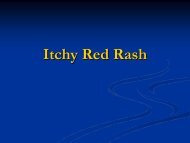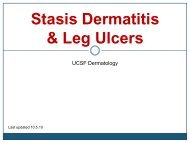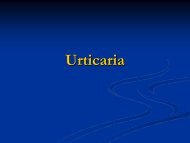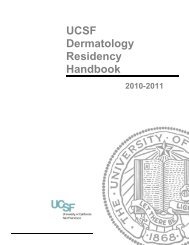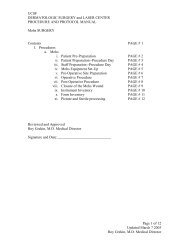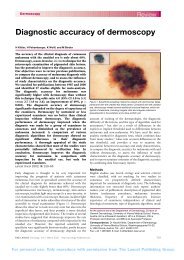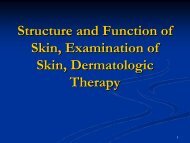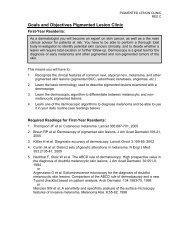The Following Module Contains Hyperlinked - Dermatology
The Following Module Contains Hyperlinked - Dermatology
The Following Module Contains Hyperlinked - Dermatology
Create successful ePaper yourself
Turn your PDF publications into a flip-book with our unique Google optimized e-Paper software.
Acne<br />
1
<strong>Module</strong> Instructions<br />
<strong>The</strong> following module contains hyperlinked<br />
information which serves to offer more<br />
information on topics you may or may not be<br />
familiar with. We encourage that you read all<br />
the hyperlinked information.<br />
2
Acne Vulgaris: Basic Facts<br />
Acne vulgaris often referred to as “acne acne” is caused by<br />
inflammation of pilosebaceous<br />
follicles.<br />
Typically presents ages 8-12 8 12 as the first sign of puberty,<br />
peaks at ages 15-18, 15 18, and resolves by age 25<br />
Affects 90% of adolescents, affects races equally, and<br />
there is often a family history<br />
12% of women and 3% of men will have acne until age<br />
44<br />
In women it is not uncommon to have a first outbreak at<br />
20-35 20 35 years of age<br />
3
Acne Vulgaris: Types<br />
<strong>The</strong>re are many morphologies seen in acne including<br />
open and comedones, comedones,<br />
papules, papules,<br />
pustules, pustules,<br />
and cysts<br />
(inflammatory nodules on the fat).<br />
<br />
Comedones are the hallmark lesion of acne vulgaris<br />
Acne comedo<br />
is a mild form that involves only the<br />
presence of comedones, or blackheads<br />
Papular acne is a form with more papules and pustules<br />
that occurs in individuals with course/oily skin<br />
Permanent scarring and cysts are sequelae<br />
of acne and<br />
therefore acne must be treated aggressively!<br />
4
Case 1<br />
5
Case 1: History<br />
HPI: 18-year 18 year-old old healthy adolescent that presents with<br />
2 years of “pimples pimples” on his face. He washes his face<br />
regularly and reports that he began to note increased<br />
pubic hair at the time of onset<br />
PMH: none<br />
All: none<br />
Meds: none<br />
FH: father and mother had acne as children<br />
SH: lives at home with parents and attends high school<br />
ROS: negative<br />
6
Case 1: Exam<br />
7
Acne Vulgaris Classification<br />
Grade 1: Open comedones<br />
Grade 2: Open and close comedones<br />
and some papulopustules<br />
Grade 3: Pustular Acne<br />
Grade 4: Nodulocystic Acne<br />
8
Case 1: Question 1<br />
Which grade of acne would you assign this<br />
patient based on his exam?<br />
a. Grade 1<br />
b. Grade 2<br />
c. Grade 3<br />
d. Grade 4<br />
9
Case 1: Question 1<br />
Answer: c<br />
Which grade of acne would you assign this<br />
patient based on his exam?<br />
a. Grade 1<br />
b. Grade 2<br />
c. Grade 3<br />
d. Grade 4<br />
10
Case 1: Grade 3 Acne Vulgaris<br />
Exam: 10-20 scattered<br />
pustules , inflammatory<br />
papules, and open<br />
comedones<br />
Pustule<br />
Open comedone<br />
Inflamed papule<br />
11
How would you grade the<br />
following acne patients?<br />
12
Grade ? Acne Vulgaris<br />
13
Grade 2<br />
Acne Vulgaris<br />
On exam: 20-30<br />
scattered<br />
erythematous papules<br />
and comedones with<br />
minimal pustules<br />
14
Grade ? Acne Vulgaris<br />
15
Grade 4<br />
Acne Vulgaris<br />
On exam: scattered<br />
comedones, erythematous<br />
papules, cysts and some<br />
residual scarring on the face<br />
with more severe scattered<br />
pitted scars of the upper back<br />
16
Now back to Case 1<br />
17
Case 1: Question 1<br />
What elements in the history are important to ask in<br />
this case?<br />
a. medications for other conditions<br />
b. dietary history<br />
c. weight gaining and other supplements<br />
d. all of the above<br />
18
Case 1: Question 1<br />
Answer: d<br />
What elements in the history are important to ask in<br />
this case?<br />
a. medications for other conditions<br />
b. dietary history<br />
c. weight gaining and other supplements<br />
d. all of the above<br />
19
Importance of History Items<br />
Medications:<br />
Medications<br />
A number of medication can cause or worsen acne including:<br />
Lithium<br />
Dilantin (phenytoin ( phenytoin)<br />
Systemic corticosteroids<br />
Androgens<br />
Diet: Diet<br />
Diets with high glycemic load may also worsen acne. Lowering<br />
the glycemic load of the diet may improve acne. Chocolate and<br />
oils in the diet are NOT causal except through this mechanism.<br />
Weight gain and supplements:<br />
If a young patient is gaining weight and on supplements, anabolic anabolic<br />
steroids should be explored<br />
20
Case 1: Question 2<br />
Which is(are) is(are)<br />
pathogenically related to the appearance<br />
of acne vulgaris?<br />
a. bacteria in the hair follicle<br />
b. androgens in the circulation<br />
c. follicular plugging<br />
d. sebum secretion<br />
e. all of the above<br />
21
Answer: e<br />
<br />
Case 1: Question 2<br />
Which is(are) is(are)<br />
pathogenically related to the appearance<br />
of acne vulgaris?<br />
a. bacteria in the hair follicle<br />
b. androgens in the circulation<br />
c. follicular plugging<br />
d. sebum secretion<br />
e. all of the above<br />
22
Acne Vulgaris: Pathogenesis<br />
Acne Vulgaris is related to 4 factors:<br />
<br />
<br />
<br />
<br />
1. Presence of hormones (androgens)<br />
2. Sebaceous gland activity (increased in presence of<br />
androgens)<br />
3. P. acnes (bacteria) in the hair follicle (it lives on<br />
the oil and breaks it down to free fatty acids which<br />
cause inflammation)<br />
4. Plugging of the hair follicle as a result of abnormal<br />
keratinization<br />
of the upper portion<br />
23
Case 1: Question 3<br />
Which of the following agents are effective in<br />
treating acne vulgaris?<br />
a. oral antibiotics<br />
b. topical benzoyl peroxide<br />
c. topical retinoids<br />
d. all of the above<br />
24
Case 1: Question 3<br />
Answer: d<br />
Which of the following agents are effective in<br />
treating acne vulgaris?<br />
a. oral antibiotics<br />
b. topical benzoyl peroxide<br />
c. topical retinoids<br />
d. all of the above<br />
25
Treatment of Acne Vulgaris<br />
<strong>The</strong> treatments for acne are directed<br />
at one or more of the 4 causative factors.<br />
In combining agents therapeutically, agents<br />
with activity against different pathogenic<br />
causes should be used (e.g. topical antibiotic<br />
plus tretinoin)<br />
Acne causes facial disfigurement and scarring<br />
is difficult to treat!<br />
<br />
Aggressive prevention is important<br />
26
Acne Vulgaris: Treatments<br />
<strong>The</strong>re are two main classes of treatments:<br />
<br />
Antibacterials<br />
–<br />
prevents bacterial component<br />
Topical: Erythromycin, clindamycin, sulfur, benzoyl<br />
peroxide<br />
Systemic: Tetracycline, doxycycline, minocycline<br />
Anti-comedonal<br />
Anti comedonal – affects keratinization<br />
Topical: Tretinoin<br />
[Retin Retin-A], A], adapalene [Differin],<br />
benzoyl peroxide<br />
Systemic: Accutane<br />
(isotretinoin isotretinoin)<br />
Washing the face DOES NOT help to prevent acne<br />
27
Guidelines for Acne Vulgaris Treatment<br />
<br />
<br />
<br />
Grade 1/2: Benzoyl Peroxide, topical<br />
antibiotics, topical sulfur, Retin A<br />
Grade 3: Oral antibiotics PLUS adequate<br />
topical therapy; hormonal therapy<br />
Grade 4: Oral Antibiotics; Accutane<br />
28
Typical Treatment Regimen<br />
GRADE TREATMENT OPTION<br />
Grade 1 Tretinoin<br />
[Retin Retin-A]*, A]*, adapalene<br />
benzoyl peroxide<br />
[Differin Differin], ],<br />
Grade 2 Benzoyl<br />
peroxide**, topical antibiotics<br />
(erythromycin 2%, clindamycin<br />
1%), Tretinoin<br />
[Retin Retin-A]*, A]*, adapalene<br />
[Differin Differin]<br />
Grade 3 Oral antibiotics, typically either tetracycline<br />
500mg bid-qid bid qid, , doxycycline<br />
100mg or<br />
minocycline 100 qd-bid qd bid<br />
Combining with benzoyl peroxide may decrease<br />
resistance. Resistance highest with tetracycline<br />
Grade 4 Accutane<br />
(isotretinoin isotretinoin) ) starting at 0.5mg/kg up to<br />
1mg/kg divided in 2 doses for ~5mo<br />
May lead to remission of acne<br />
*Available in cream, gel, solution with 0.025% cream the weakest and 0.05% solution the<br />
strongest. Most common is 0.025 and 0.05% creams for less irritation.<br />
**Available in 2.5, 5, 10% gel and cream as well as combined gels with erythromycin and clindamycin<br />
29
Side Effects<br />
A common side effect of topical agents (especially benzoyl peroxide peroxide<br />
and tretinoin) tretinoin)<br />
is skin drying, Retin-A Retin A can cause severe erythema. erythema<br />
A common side effect of oral tetracyclines<br />
is GI upset and is also<br />
contraindicated in pregnancy and children
Accutane<br />
It is difficult to prescribe accutane<br />
and requires<br />
paperwork, so when is it indicated in acne?<br />
<br />
<br />
<br />
<br />
Severe cystic (grade 4) acne<br />
Poorly responsive acne improving
Cosmetics and Acne<br />
Cosmetics are labeled as “non non-comedogenic<br />
comedogenic” if<br />
they do not cause or exacerbate acne<br />
Many sunblocks and moisturizers<br />
may exacerbate acne so products must be<br />
selected carefully<br />
Overaggressive washing and the use of<br />
particulate abrasive scrubs often exacerbates<br />
acne and should be avoided (you can not scrub<br />
out the plugs in your pores)<br />
32
Case 2<br />
33
Case 2: History<br />
HPI: A 22 year old female patient comes in stating that she<br />
has started to develop acne that she did not have before.<br />
PMH: none<br />
All: none<br />
Meds: none<br />
FH: none<br />
SH: pt lives in the city and attends college. She has poor<br />
diet and exercise habits due to lack of time and has gained<br />
40 pounds over the past 4 years.<br />
ROS: some new upper lip and chin hair growth and<br />
irregular menstrual cycles<br />
34
Case 2: Exam<br />
On exam:<br />
Gen: pt is well appearing in NAD, but<br />
overweight<br />
Skin: 30-40 scattered comedones,<br />
erythematous papules some with<br />
overlying crust on the cheeks.<br />
Some fine black terminal hairs noted on<br />
the upper lip and chin as well as hair loss<br />
on the frontal and parietal scalp<br />
(androgenetic alopecia)<br />
35
Case 2: Question 1<br />
<strong>The</strong> patient was given spironolactone<br />
and her<br />
acne resolved. Why did this medication work?<br />
36
Case 2: Question 1<br />
<strong>The</strong> patient was given spironolactone<br />
and her acne<br />
resolved. Why did this medication work?<br />
a. the diuretic effect of spironolactone<br />
eliminated<br />
sodium resulting in less sebum<br />
b. the spironolactone<br />
has anti-androgenic anti androgenic effects<br />
c. spironolactone<br />
has anti-comedonal<br />
anti comedonal activity<br />
d. spironolactone<br />
when used appropriately has anti-<br />
bacterial activity<br />
37
Case 2: Question 1<br />
<strong>The</strong> patient was given spironolactone<br />
and her acne<br />
resolved. Why did this medication work?<br />
a. the diuretic effect of spironolactone<br />
eliminated<br />
sodium resulting in less sebum (not true)<br />
b. the spironolactone<br />
has anti-androgenic<br />
anti androgenic<br />
effects<br />
c. spironolactone<br />
has anti-comedonal<br />
anti comedonal activity (not true)<br />
d. spironolactone<br />
when used appropriately has anti-<br />
bacterial activity (not true)<br />
38
Androgen Excess in Acne<br />
<strong>The</strong> patient has likely polycystic ovarian syndrome<br />
(PCOS)<br />
<br />
<br />
Weight gain and “metabolic metabolic syndrome” syndrome is a common cause of<br />
this disorder<br />
Hirsuitism results from increased circulating androgens<br />
Some women with acne after adolescence<br />
have hormonally driven acne<br />
In women past the age of 25, treatment of androgen<br />
excess can improve acne.<br />
Commonly used agents are:<br />
<br />
<br />
Spironolactone 50mg -100mg 100mg daily<br />
OCP’s OCP s (oral contraceptives)<br />
39
Case 3<br />
40
Case 3: History<br />
HPI: 33-year 33 year-old old female complains of<br />
red cheeks for the past year.<br />
PMH: none<br />
All: none<br />
Meds: none<br />
FH: none<br />
SH: homeless, chronic alcoholic<br />
ROS: negative<br />
41
Case 3: Exam<br />
On exam:<br />
Facial erythema with papules<br />
and pustules on the nose and<br />
cheeks as well as some<br />
scattered papules and<br />
pustules on the forehead and<br />
chin<br />
NO COMEDONES<br />
42
Case 3: Question 1<br />
What is the most likely diagnosis?<br />
a. systemic Lupus Erythematosus<br />
b. bacterial folliculitis<br />
with cellulitis<br />
c. acne rosacea<br />
d. pellagra from niacin deficiency<br />
43
Case 3: Question 1<br />
Answer: c<br />
What is the most likely diagnosis?<br />
a. systemic lupus erythematosus<br />
(does not<br />
present with pustules)<br />
b. bacterial folliculitis<br />
with cellulitis (pt does not<br />
have acute or systemic symptoms)<br />
c. acne rosacea<br />
d. pellagra from niacin deficiency (would expect scale<br />
but not pustules)<br />
44
Acne Rosacea: Basic Facts<br />
Acne rosacea is a chronic inflammatory<br />
condition located at the “flush flush” areas of the face<br />
(nose, cheeks > brow, chin)<br />
It is more common in women<br />
It is most often in people of middle age (30-50) (30 50)<br />
Affected persons blush easily<br />
45
Case 3: Question 2<br />
Which of the following might trigger<br />
this patient’s patient s rosacea?<br />
a. alcohol<br />
b. heat/hot beverages<br />
c. sunlight<br />
d. hot, spicy foods<br />
e. all of the above<br />
46
Case 3: Question 2<br />
Answer: e<br />
Which of the following might trigger<br />
this patient’s patient s rosacea?<br />
a. alcohol<br />
b. heat/hot beverages<br />
c. sunlight<br />
d. hot, spicy foods<br />
e. all of the above<br />
47
Acne Rosacea Triggers<br />
Alcohol<br />
Sunlight<br />
Hot beverages (heat)<br />
Hot, spicy food<br />
If it makes you flush it can flare rosacea<br />
Rosacea is NOT related to androgens!!<br />
48
Clinical Features of Acne Rosacea<br />
Disease is typically located on the mid face including<br />
the nose and cheeks with occasional involvement of the<br />
brow, chin, eyelids, and eyes<br />
Patient’s Patient s have erythema<br />
and telangiectasias<br />
Patient’s Patient s also can have papules and pustules<br />
(NO COMEDONES!)<br />
Rhinophyma<br />
(W.C. Fields nose)<br />
<br />
Dermal and sebaceous gland hyperplasia of the nose<br />
Ocular rosacea<br />
(keratitis, blepharitis, conjunctivitis)<br />
49
Some Examples of<br />
Rosacea<br />
50
Erythematotelangiectatic<br />
Rosacea<br />
On exam: patient has subtle<br />
erythema on the cheeks and<br />
nose with telangiectasia<br />
scattered throughout the nose<br />
and cheeks. <strong>The</strong>re are no<br />
papules, pustules, or<br />
comedones present<br />
51
Papulopustular<br />
Rosacea<br />
On exam: pt has<br />
erythema on the nose<br />
with scattered papules<br />
and pustules. Pt also has<br />
erythema with papules<br />
and pustules on the chin<br />
52
Glandular Rosacea<br />
On exam: pt has facial<br />
erythema of the forehead,<br />
cheeks, and nose as well as<br />
scattered papules, pustules,<br />
and cysts on the nose, cheeks,<br />
and forehead. Scattered<br />
nodulocystic lesions are also<br />
present. Pt also has<br />
rhinophyma.<br />
53
Acne Rosacea Treatment<br />
Medical treatment is only effective for<br />
the papulopustular and glandular variants. <strong>The</strong><br />
underlying erythema<br />
may not respond to<br />
medical treatment.<br />
Treatment options include:<br />
<br />
<br />
<br />
<br />
Topical Antibiotics (metronidazole<br />
( metronidazole)<br />
Topical Sulfur<br />
Oral Antibiotics (tetracyclines<br />
( tetracyclines)<br />
Isotretinoin<br />
(accutane accutane) ) is considered in severe cases<br />
<strong>The</strong>rapy is only suppressive and thus may be<br />
required lifelong<br />
54
Using Steroids in Rosacea?<br />
Topical Steroids may exacerbate or induce<br />
an acneiform eruption resembling rosacea called steroid<br />
rosacea<br />
Treatment involves stopping the topical steroids and<br />
giving oral tetracyclines<br />
NEVER treat an undiagnosed central facial papular<br />
eruption with topical steroids. It may be rosacea which<br />
will flare severely when the topical steroids are stopped!<br />
55
Acne Rosacea Surgical Treatment<br />
<br />
Laser therapy can be used to improve the<br />
telangiectasias and the rhinophyma<br />
once the<br />
papulopustular component is controlled with<br />
oral or topical medications<br />
56
END OF MODULE<br />
57



